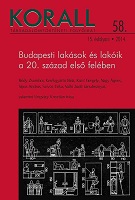Ki az úr a házban? Küzdelmek a budapesti lakásbérleti jog körül az 1860-as évektől az 1930-as évekig
Who’s the Master of the House? Conflicts of the Tenancy Law in Budapest from the 1860s to the 1930s
Author(s): András SiposSubject(s): History
Published by: KORALL Társadalomtörténeti Egyesület
Summary/Abstract: From the second half of the nineteenth century onwards, apartment buildings as business investment, as well as the concept of rented apartment as a housing option and living space, became increasingly common, which was one of the key elements of modern urban lifestyle. At the same time, housing also became one of the major areas of social conflict. In cities, the detailed regulation of tenancy, which defined the rights of and power structure between landlords, lessors and tenants was largely laid out in municipal ordinances. In Budapest, tenancy law underwent comprehensive revision first in 1882–85, then in 1909 and 1936. The latter two revisions were undertaken in a period when urban housing was beginning to be perceived as a social problem in politics, public discourse (a matter of heated disputes even), which were soon buried under nearly impenetrable layers of agendas and interpretation. The study examines the concepts and ways of argumentation which emerge in the legislative process. This methodology allows the long term examination of various research questions, such as how the inherently commercial relationship between landlords and tenants became a matter of public policy, what changes the interpretive framework underwent in the period, and what legal means were considered acceptable within this framework.
Journal: Korall - Társadalomtörténeti folyóirat
- Issue Year: 2014
- Issue No: 58
- Page Range: 44-68
- Page Count: 25
- Language: Hungarian

